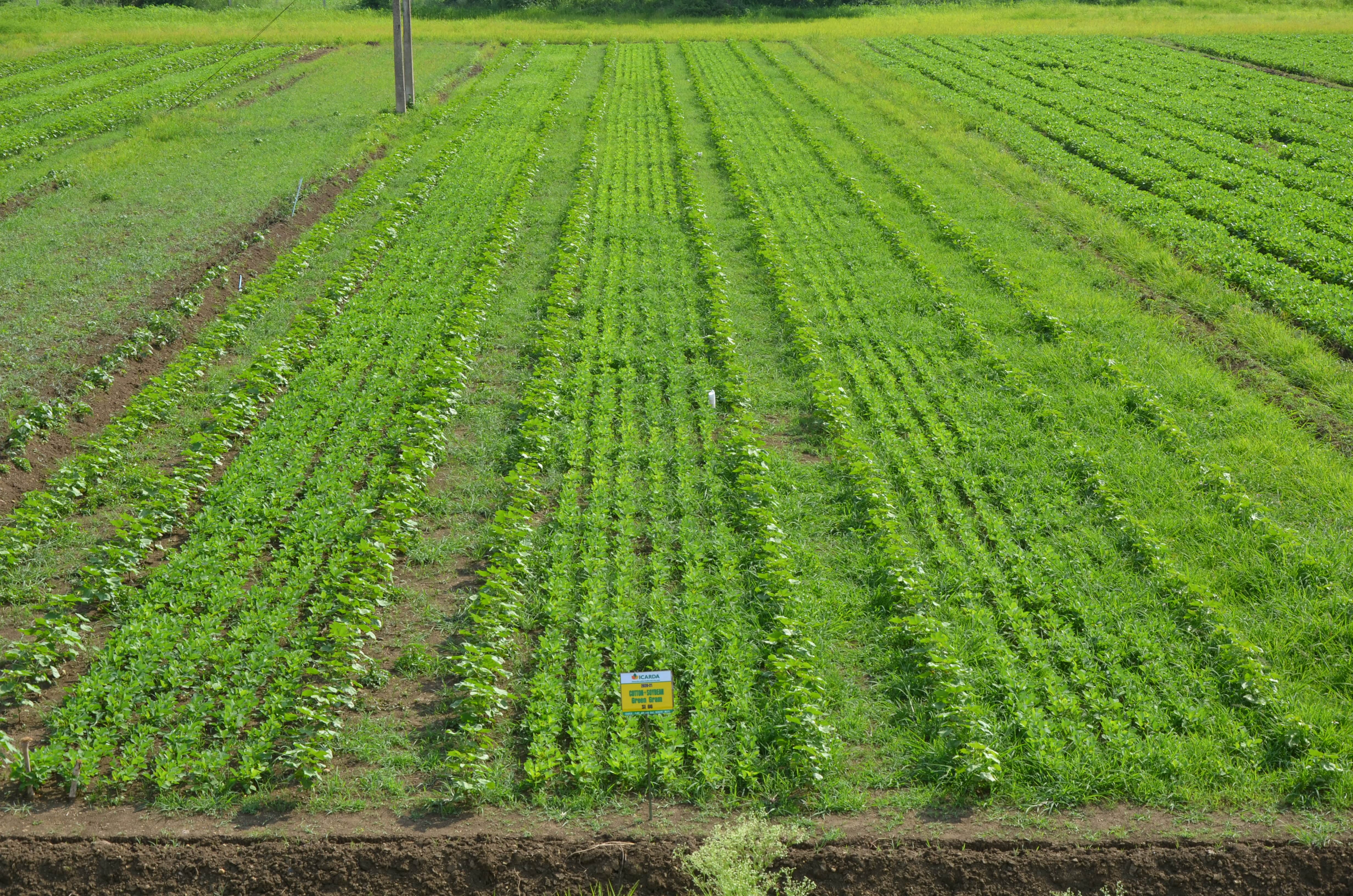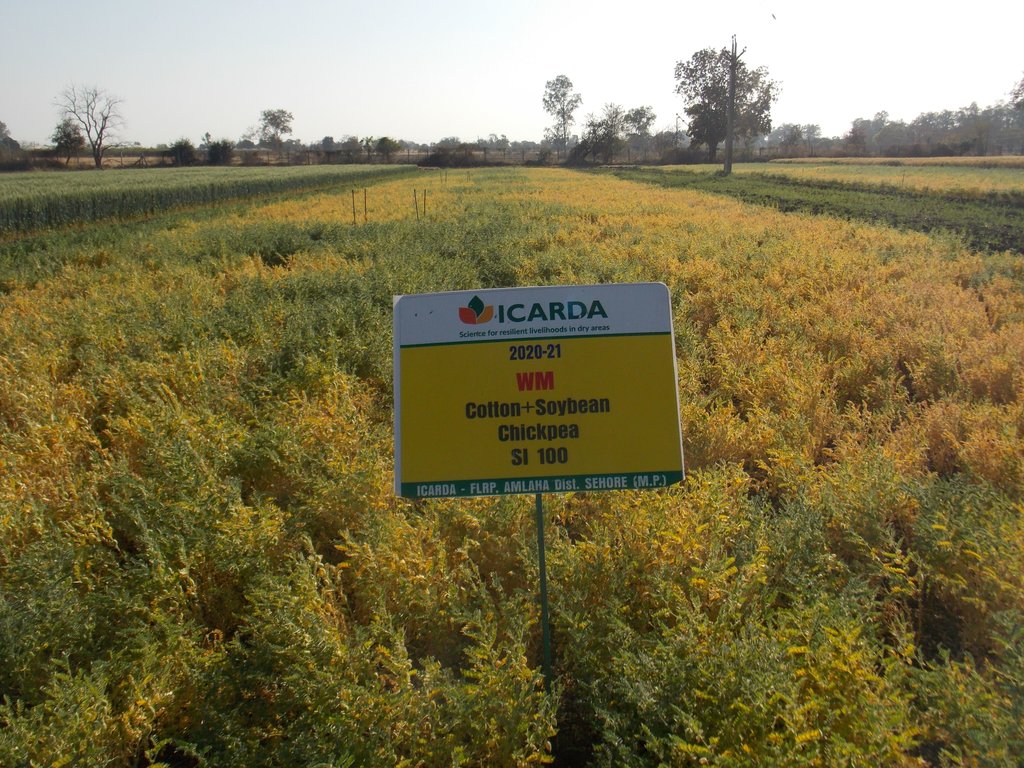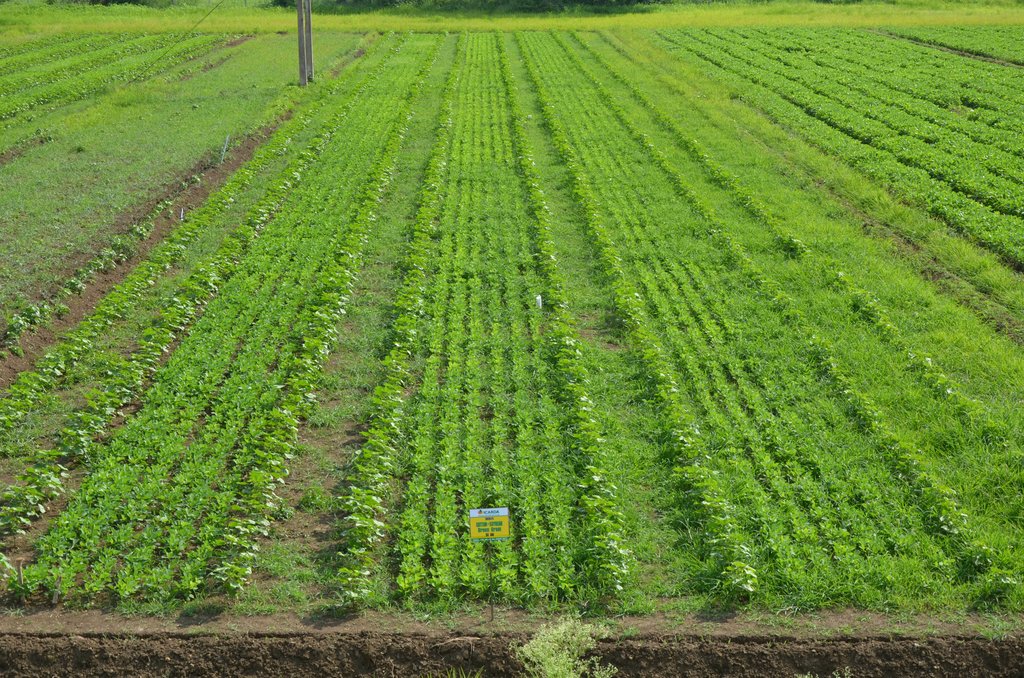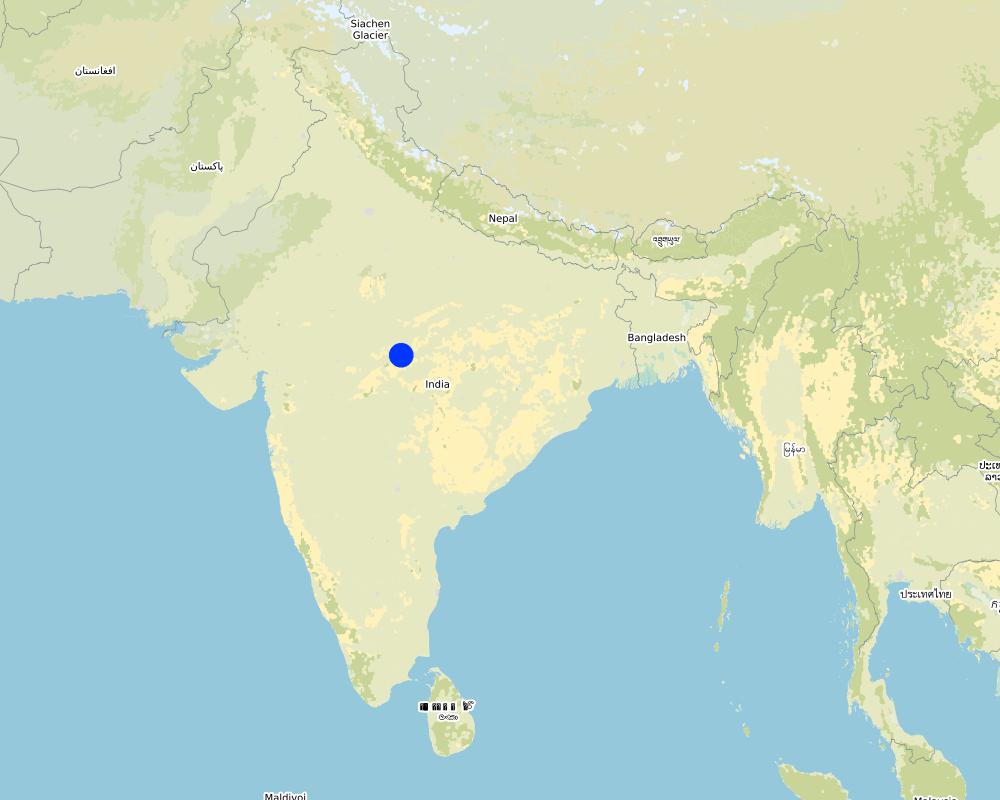Supplemental Irrigation in a Legume-Cotton Production System [ប្រទេសឥណ្ឌា]
- ការបង្កើត៖
- បច្ចុប្បន្នភាព
- អ្នកចងក្រង៖ Joren Verbist
- អ្នកកែសម្រួល៖ –
- អ្នកត្រួតពិនិត្យច្រើនទៀត៖ William Critchley, Rima Mekdaschi Studer
technologies_5820 - ប្រទេសឥណ្ឌា
ពិនិត្យមើលគ្រប់ផ្នែក
ពង្រីកមើលទាំងអស់ បង្រួមទាំងអស់1. ព័ត៌មានទូទៅ
1.2 ព័ត៌មានលម្អិតពីបុគ្គលសំខាន់ៗ និងស្ថាប័នដែលចូលរួមក្នុងការវាយតម្លៃ និងចងក្រងឯកសារនៃបច្ចេកទេស
បុគ្គលសំខាន់ម្នាក់ (ច្រើននាក់)
Research Team Leader - Soils, Waters and Agronomy:
Nangia Vinay
International Center of Agriculture Research in the Dry Areas (ICARDA)
ប្រទេសម៉ារ៉ុក
Research Associate Agronomy:
Sinha Rajni
International Center of Agriculture Research in the Dry Areas (ICARDA)
ប្រទេសឥណ្ឌា
ឈ្មោះគម្រោងដែលបានចងក្រងឯកសារ/ វាយតម្លៃលើបច្ចេកទេស (បើទាក់ទង)
ICARDA Institutional Knowledge Management Initiativeឈ្មោះអង្គភាពមួយ (ច្រើន) ដែលបានចងក្រងឯកសារ/ វាយតម្លៃបច្ចេកទេស (បើទាក់ទង)
International Center for Agricultural Research in the Dry Areas (ICARDA) - ប្រទេសលីបង់1.3 លក្ខខណ្ឌទាក់ទងទៅនឹងការប្រើប្រាស់ទិន្នន័យដែលបានចងក្រងតាមរយៈ វ៉ូខេត
អ្នកចងក្រង និង(បុគ្គលសំខាន់ៗ)យល់ព្រមទទួលយកនូវលក្ខខណ្ឌនានាទាក់ទងទៅនឹងការប្រើប្រាស់ទិន្នន័យដែលបានចងក្រងតាមរយៈវ៉ូខេត:
បាទ/ចា៎
1.4 សេចក្តីប្រកាសស្តីពីចីរភាពនៃការពណ៌នាពីបច្ចេកទេស
តើបច្ចេកទេសដែលបានពណ៌នានេះមានបញ្ហាដែលផ្តោតលើការធ្លាក់ចុះគុណភាពដី, បើដូច្នេះវាមិនអាចត្រូវបានប្រកាសថាជាបច្ចេកទេសនៃការគ្រប់គ្រងប្រកបដោយចីរភាពទេ?
ទេ
2. ការពណ៌នាពីបច្ចេកទេស SLM
2.1 ការពណ៌នាដោយសង្ខេបពីបច្ចេកទេស
និយមន័យបច្ចេកទេស:
Supplemental Irrigation (SI) offers a solution for irregular rainfall, as it provides a limited amount of water to essentially rainfed crops consequently ensuring good plant growth. Furthermore, SI provides the opportunity for a more diverse production system such as a legume-cotton system in which chickpeas are cultivated as a winter crop, and soybean and cotton are inter-cropped in the summer.
2.2 ការពណ៌នាលម្អិតពីបច្ចេកទេស
ការពណ៌នា:
The state of Madhya Pradesh (India) has an average annual rainfall of around 1170 mm. However, data shows a declining trend. It is characterized by a monsoon period from July to September. Winter is from December to January and the summer is from February to March. The rainfall is irregular, resulting in crop failures, land degradation, nutrient leaching and shortened growing seasons. This constrains the agricultural sector, upon which 74% of the population is either directly or indirectly dependent. 38% of the agricultural area is intensively/conventionally irrigated. The majority of the water is obtained from groundwater which has led to over-exploitation.
To sustainably improve the agricultural sector, the International Center for Agricultural Research in the Dry Areas (ICARDA) introduced Supplemental Irrigation (SI). This is a practice in which essentially rainfed crops are cultivated rather than more water demanding crops. SI ensures a sufficient amount of water as rainfall satisfies the majority of the crop water demand. Water availability is not sought in (fossil) groundwater extraction, thus avoiding over-exploitation, but rather through rainwater harvesting (RWH), using the rainfall optimally. In addition, SI prolongs the growing season and enables more diverse farming systems by crop rotation and inter-cropping.
In 2018, a reservoir was constructed, with a 900,000 litres capacity. Every rainy season groundwater rises to the surface, indicating that the soil is fully saturated. The reservoir is filled by pumping the surface water from shallow wells. This is considered sustainable RWH as it assumed the pumped water is solely rainwater. An additional benefit of this approach is that no large catchment area is required. The building of the reservoir consists of 1) excavating the soil; 2) stone pitching the excavation; 3) installing polysheet to avoid water losses through infiltration. The water from the reservoir is distributed over the field by a portable (wheeled) sprinkler irrigation system. Hence, pumping from the reservoir is required.
The water from the reservoir allows for crop rotation with a winter crop, namely chickpeas. This crop grows from November till March, outside of the rainy season. Without SI, chickpea yield is poor as farmers must wait until sufficient rain has fallen before sowing, limiting the growing period. SI can provide the necessary water for the chickpeas to germinate well, ensuring a sufficient growing period. The chickpeas are manually harvested in March. Besides increased income for the farmer, chickpeas also provide valuable soil improvement as the plant fixes atmospheric nitrogen in the soil.
In additional to crop rotation, SI and water harvesting allows for a more intensive cropping system in which cotton and soybean are intercropped. These crops are planted in June-July. The intercrop ratio is two rows of cotton and six rows of soybean. Soybean and cotton are respectively threshed and harvested in October. Consequently, the plants are grown mainly in the rainy season. Fertilizer (80 kg nitrogen, 100 kg phosphorus and 60 kg potassium per hectare) is applied directly after sowing, hence June-July. In the same period the field is manually weeded. Micro-Nutrients (a mixture of B, Zn, Mn) are applied if needed. On average, this corresponds to one kilogram per hectare. Mechanical pesticide application is done from July to August by a sprayer, consisting of herbicides, fungicides and insecticides.
The frequency and amount of irrigated water through SI is unpredictable as it compensates rainfall irregularity. Nevertheless, it is advised to irrigate less than the infiltration rate of the soil, to avoid deep percolation of water and nutrient leaching. That is, it is better to irrigate small doses multiple times. For this reason, sandy soils are unsuitable as they have relatively high infiltration rates and low water holding capacity. On average, one hectare of this particular production system is irrigated through sprinklers thrice by 250 cubic meters of harvested water.
A great advantage of SI is that it leads to a year-round income through a diversified production system with an additional winter crop. Farmers also value SI ensuring stable yields, thus making them less vulnerable to rainfall irregularities. Also, the diversified system protects the crops better against epidemics. And as there are legumes included in the system, the soil quality is improved, lowering the required amount of nitrogen fertilizer.
Nevertheless, SI has some weaknesses. For example, the implementation of SI is difficult for smallholder farmers as they lack the area for a reservoir. In addition, the initial costs are high, so adoption may be restrained by the lack of available funds, especially for smallholder farmer. This specific SI, by water harvesting (extracting shallow groundwater) is not suitable in areas of poor groundwater recharge. But the concept of SI can be applied. To conclude, where it is technically and financially feasible, SI allows for more intensive, diversified and stable production system under climate change induced risks, hence supplemental irrigation is an important technique to improve the livelihoods of farmers exposed to climate change.
2.3 រូបភាពនៃបច្ចេកទេស
2.5 ប្រទេស/តំបន់/ទីតាំងកន្លែង ដែលបច្ចេកទេសត្រូវបានអនុវត្ត និងបានគ្រប់ដណ្តប់ដោយការវាយតម្លៃនេះ
ប្រទេស:
ប្រទេសឥណ្ឌា
តំបន់/រដ្ឋ/ខេត្ត:
Central India
បញ្ជាក់បន្ថែមពីលក្ខណៈនៃទីតាំង:
Madhya Pradesh
បញ្ជាក់ពីការសាយភាយនៃបច្ចេកទេស:
- ត្រូវបានផ្សព្វផ្សាយត្រឹមតំបន់មួយ
ប្រសិនបើមិនច្បាស់ពីទំហំផ្ទៃដី សូមធ្វើការប៉ាន់ប្រម៉ាណ:
- < 0.1 គម2 (10 ហិកតា)
តើបច្ចេកទេស (មួយ ឬច្រើន) ទាំងនោះស្ថិតនៅក្នុងតំបន់ការពារជាអចិន្ត្រៃយ៍ណាមួយដែរឬទេ?
ទេ
Map
×2.6 កាលបរិច្ឆេទនៃការអនុវត្ត
បង្ហាញឆ្នាំនៃការចុះអនុវត្ត:
2018
2.7 ការណែនាំពីបច្ចេកទេស
សូមបញ្ជាក់តើបច្ចេកទេសត្រូវបានណែនាំឱ្យអនុវត្តដោយរបៀបណា:
- ពេលកំពុងពិសោធន៍
- តាមរយៈគម្រោង / អន្តរាគមន៍ពីខាងក្រៅ
3. ចំណាត់ថ្នាក់នៃបច្ចេកទេស SLM
3.1 គោលបំណងចម្បង (១ ឬច្រើន) នៃបច្ចេកទេសនេះ
- ធ្វើឱ្យប្រសើរឡើងនូវផលិតកម្ម
- បន្ស៊ាំទៅនឹងការប្រែប្រួលអាកាសធាតុ/គ្រោះមហន្តរាយ និងផលប៉ះពាល់របស់វា
- បង្កើតផលប្រយោជន៍សេដ្ឋកិច្ច
- បង្កើតផលប្រយោជន៍សង្គម
3.2 ប្រភេទដីប្រើប្រាស់មួយប្រភេទ (ច្រើនប្រភេទ) ដែលបានអនុវត្តបច្ចេកទេស
ដីប្រើប្រាស់ចម្រុះនៅលើដីតែមួយ:
ទេ

ដីដាំដំណាំ
- ដំណាំប្រចាំឆ្នាំ
ដំណាំប្រចាំឆ្នាំ - បញ្ជាក់ប្រភេទដំណាំ:
- ដំណាំសរសៃ - កម្បាស ឬសំឡី
- ពពួកសណ្តែក - គ្រាប់ហោឡាំងតាវ
- ពពួកសណ្តែក - សណ្តែកសៀង
ចំនួនសារដែលដាំដំណាំក្នុងមួយឆ្នាំ:
- 2
តើជាការអនុវត្តន៍ដំណាំចន្លោះ?
បាទ/ចា៎
ប្រសិនបើបាទ/ច៎ា សូមបញ្ជាក់ប្រភេទដំណាំដែលដាំចន្លោះគ្នានោះ:
Cotton (1) and soybean (2) are intercropped in the rainy season
តើជាការអនុវត្តន៍ដំណាំវិលជុំ?
បាទ/ចា៎
បើបាទ/ច៎ា សូមបញ្ជាក់:
In the winter, chickpeas are cultivated.
3.3 បន្ទាប់ពីអនុវត្តបច្ចេកទេស តើដីប្រើប្រាស់មានការប្រែប្រួលដែររឺទេ?
បន្ទាប់ពីអនុវត្តបច្ចេកទេស តើដីប្រើប្រាស់មានការប្រែប្រួលដែររឺទេ?
- បាទ/ច៎ា (សូមបំពេញសំណួរខាងក្រោមពីស្ថានភាពដីប្រើប្រាស់មុនពេលអនុវត្តបច្ចេកទេស)

ដីដាំដំណាំ
- ដំណាំប្រចាំឆ្នាំ
ដំណាំប្រចាំឆ្នាំ - បញ្ជាក់ប្រភេទដំណាំ:
- ពពួកសណ្តែក - គ្រាប់ហោឡាំងតាវ
- ពពួកសណ្តែក - សណ្តែកសៀង
តើជាការអនុវត្តន៍ដំណាំវិលជុំ?
បាទ/ចា៎
3.4 ការផ្គត់ផ្គង់ទឹក
ការផ្គត់ផ្គង់ទឹកនៅកន្លែងអនុវត្តបច្ចេកទេស:
- ទឹកភ្លៀង និងប្រព័ន្ធស្រោចស្រព
3.5 ក្រុម SLM ដែលបច្ចេកទេសស្ថិតនៅក្នុង
- ប្រព័ន្ធដំណាំបង្វិល (ការដាំដំណាំវិលជុំ ការទុកដីចោលដើម្បីបង្កើនជីជាតិ កសិកម្មពនេចរ)
- ការស្តុកទុកទឹក
- ការគ្រប់គ្រងប្រព័ន្ធស្រោចស្រព (រួមទាំងការផ្គត់ផ្គង់ទឹក ប្រព័ន្ធបង្ហូរ)
3.6 វិធានការ SLM ដែលបញ្ចូលនូវបច្ចេកទេស

វិធានការក្សេត្រសាស្ត្រ
- A1: ដំណាំ/គម្របដី
- A3: ការរក្សាស្រទាប់ដីខាងលើ
A3: ប្រព័ន្ធភ្ជួររាស់ខុសៗគ្នា:
A 3.1: មិនភ្ជួររាស់

វិធានការរុក្ខជាតិ

វិធានការរចនាស័ម្ពន្ធ
- S5: ទំនប់ ថ្លុក ស្រះ
- S7: ការប្រមូលទឹកស្តុកទុក/ផ្គត់ផ្គង់ទឹក/ សម្ភារៈស្រោចស្រព

វិធានការគ្រប់គ្រង
- M2: ការផ្លាស់ប្តូរការគ្រប់គ្រង/ កម្រិតអាំងតង់ស៊ីតេ
3.7 កំណត់ប្រភេទនៃការធ្លាក់ចុះគុណភាពដីសំខាន់ៗដែលបច្ចេកទេសនេះបានដោះស្រាយ

ការហូរច្រោះដីដោយសារទឹក
- Wt: ការបាត់ដីស្រទាប់លើដោយការហូរច្រោះ

ការបាត់ដីដោយសារខ្យល់
- Et: ការបាត់បង់ដីស្រទាប់លើ

ការធ្លាក់ចុះសារធាតុគីមីក្នុងដី
- Cs: សារធាតុប្រៃ/អាល់កាឡាំង

ការបាត់បង់រូបសាស្ត្រនៃដី
- Pw: ទឹកនៅដក់ជាប់

ការធ្លាក់ចុះជីវសាស្ត្រនៃដី
- Bc: ការថយចុះនូវគម្របរុក្ខជាតិ
- Bq: ការថយចុះនូវជីវម៉ាស/ បរិមាណ

ការបាត់បង់ទឹក
- Ha: ការថយចុះសំណើមដី
- Hs: ការប្រែប្រួលបរិមាណទឹកនៅលើផ្ទៃដី
- Hg: ការប្រែប្រួលបរិមាណទឹកនៅក្រោមដី
3.8 ការពារ កាត់បន្ថយ ឬស្តារឡើងវិញនៃការធ្លាក់ចុះគុណភាពដី
បញ្ជាក់ពីគោលដៅរបស់បច្ចេកទេស ដែលផ្តោតទៅការធ្លាក់ចុះគុណភាពដី:
- ការបន្ស៊ាំទៅនឹងការធ្លាក់ចុះគុណភាពដី
4. បច្ចេកទេសជាក់លាក់ សកម្មភាពអនុវត្ត ធាតុចូល និងថ្លៃដើម
4.1 គំនូសបច្ចេកទេសនៃបច្ចេកទេសនេះ
លក្ខណៈពិសេសនៃបច្ចេកទេស (ទាក់ទងនឺងគំនូរបច្ចេកទេស):
The dimensions are :
-A: 46 meter
-B: 35 meter
-C: 29 meter
-D: 140 degrees
-E: 9 meter
-F: 3.8 meter
-G: 3.2 meter
The reservoir has a capacity of 9 000 cubic meter water. It is lined with 2847 square meter of polysheet to avoid water losses through infiltration.
លក្ខណៈពិសេសនៃបច្ចេកទេស (ទាក់ទងនឺងគំនូរបច្ចេកទេស):
The dimension related to the Winter-crop Chickpeas (in cm):
Spacing between rows (A) = 30
Spacing between plants within rows (B) = 15
ឈ្មោះអ្នកនិពន្ធ:
Joren Verbist
កាលបរិច្ឆេទ:
12/02/2021
លក្ខណៈពិសេសនៃបច្ចេកទេស (ទាក់ទងនឺងគំនូរបច្ចេកទេស):
The dimensions related to the Soybean Cotton intercropping (in cm):
Spacing between soybean within row (A) = 15
Spacing between rows of soybean (B) = 30
Spacing between a row of cotton and a row of soybean (C) = 60
Spacing between cotton within a row (D) = 60
Spacing between cotton and cotton = 90
ឈ្មោះអ្នកនិពន្ធ:
Joren Verbist
កាលបរិច្ឆេទ:
12/02/2021
4.2 ព័ត៌មានទូទៅដែលពាក់ព័ន្ធនឹងការគណនាធាតុចូល និងថ្លៃដើម
កំណត់របៀបនៃការគណនាថ្លៃដើម និងធាតុចូល:
- ក្នុងតំបន់អនុវត្តបច្ចេកទេស
កំណត់ទំហំ និងឯកត្តាផ្ទៃដី:
6.4 hectares
ផ្សេងៗ/ រូបិយប័ណ្ណជាតិ (បញ្ជាក់):
INR
បើពាក់ព័ន្ធសូមកំណត់អត្រាប្តូរប្រាក់ពីដុល្លាទៅរូបិយប័ណ្ណតំបន់ (ឧ. 1 ដុល្លារ = 79.9 រៀលនៃរូបិយប័ណ្ណប្រេស៊ីល) ៖ 1 ដុល្លារ =:
73,52
កំណត់ថ្លៃឈ្នួលជាមធ្យមនៃការជួលកម្លាំងពលកម្មក្នុងមួយថ្ងៃ:
37.5
4.3 សកម្មភាពបង្កើត
| សកម្មភាព | រយៈពេល (រដូវកាល) | |
|---|---|---|
| 1. | Earth Work | Summer Season (May) |
| 2. | Pitching | Summer Season (May) |
| 3. | Polysheet Installation | Summer Season (May) |
| 4. | Filling water | Rainy Season |
| 5. | Installing Irrigation System | At time of irrigation (as it is portable) |
4.4 ថ្លៃដើម និងធាតុចូលដែលត្រូវការសម្រាប់ការបង្កើតបច្ចេកទេស
| បញ្ជាក់ពីធាតុចូល | ឯកតា | បរិមាណ | ថ្លៃដើមក្នុងមួយឯកតា | ថ្លៃធាតុចូលសរុប | % នៃថ្លៃដើមដែលចំណាយដោយអ្នកប្រើប្រាស់ដី | |
|---|---|---|---|---|---|---|
| កម្លាំងពលកម្ម | Pond Excavation | m2 | 53,0 | 4000,0 | 212000,0 | 100,0 |
| កម្លាំងពលកម្ម | Sprinker Operation | Person Hour | 1,0 | 37,5 | 37,5 | 100,0 |
| សម្ភារៈ | Zero Tillage Seed Drill | Machine | 1,0 | 55000,0 | 55000,0 | 100,0 |
| សម្ភារៈ | Sprinkler System (portable) | System | 1,0 | 28300,0 | 28300,0 | 100,0 |
| សម្ភារៈសាងសង់ | Micron-Geo-Membrane | m2 | 2857,0 | 105,0 | 299985,0 | 100,0 |
| ផ្សេងៗ | Tax (18%) | Total | 1,0 | 38160,0 | 38160,0 | 100,0 |
| ថ្លៃដើមសរុបក្នុងការបង្កើតបច្ចេកទេស | 633482,5 | |||||
| ថ្លៃដើមសរុបក្នុងការបង្កើតបច្ចេកទេសគិតជាដុល្លារ | 8616,46 | |||||
4.5 សកម្មភាពថែទាំ
| សកម្មភាព | ពេលវេលា/ ភាពញឹកញាប់ | |
|---|---|---|
| 1. | Sowing Chickpeas | November |
| 2. | Sowing Cotton and Soybean | June-July |
| 3. | Weeding | July-August |
| 4. | Fertilizer Application | June-July |
| 5. | Micro-Nutrient Application | Upon Inspection (June) |
| 6. | Irrigation | If needed (throughout growing season) |
| 7. | Pesticide Application | July-August |
| 8. | Harvesting Chickpeas | March |
| 9. | Picking Cotton | October |
| 10. | Threshing Soybean | October |
4.6 កំណត់ថ្លៃដើមសម្រាប់ការថែទាំ/ សកម្មភាពរបស់បច្ចេកទេស (ក្នុងរយៈពេលមួយឆ្នាំ)
| បញ្ជាក់ពីធាតុចូល | ឯកតា | បរិមាណ | ថ្លៃដើមក្នុងមួយឯកតា | ថ្លៃធាតុចូលសរុប | % នៃថ្លៃដើមដែលចំណាយដោយអ្នកប្រើប្រាស់ដី | |
|---|---|---|---|---|---|---|
| កម្លាំងពលកម្ម | Total Labour (inc sowing, fertilizer, irrigation, threshing, etc) | Peron-Hours | 640,0 | 37,5 | 24000,0 | 100,0 |
| សម្ភារៈ | Sowing (Zero-Tillage Seeder) | Machine-Hours | 57,0 | 500,0 | 28500,0 | 100,0 |
| សម្ភារៈ | Threshing Soybean (Thresher) | Machine-Hours | 51,0 | 300,0 | 15300,0 | 100,0 |
| សម្ភារៈ | Sprayer (weeding) | Machine-Hours | 51,0 | 300,0 | 15300,0 | 100,0 |
| សម្ភារៈដាំដុះ | Chickpeas Seeds | Kilogram | 448,0 | 450,0 | 201600,0 | 100,0 |
| សម្ភារៈដាំដុះ | Cotton Seeds | Kilogram | 10,0 | 1400,0 | 14000,0 | 100,0 |
| សម្ភារៈដាំដុះ | Soybean Seeds | Kilogram | 256,0 | 150,0 | 38400,0 | 100,0 |
| ជី និងសារធាតុពុល | Micro-Nutrients (mixture of B, Zn, Mn) | Kilogram | 6,4 | 900,0 | 5760,0 | 100,0 |
| ជី និងសារធាតុពុល | Nitrogen (Urea) | Kilogram | 510,0 | 6,0 | 3060,0 | 100,0 |
| ជី និងសារធាតុពុល | Phosphorus (DAP) | Kilogram | 640,0 | 25,4 | 16256,0 | 100,0 |
| ជី និងសារធាតុពុល | Potassium (MOP) | Kilogram | 380,0 | 36,0 | 13680,0 | 100,0 |
| ជី និងសារធាតុពុល | Herbicide | Liter | 6,4 | 470,0 | 3008,0 | 100,0 |
| ជី និងសារធាតុពុល | Fungicide | Liter | 3,2 | 570,0 | 1824,0 | 100,0 |
| ជី និងសារធាតុពុល | Insecticide | Liter | 3,2 | 580,0 | 1856,0 | 100,0 |
| ផ្សេងៗ | Cost Irrigation | Total | 6,4 | 250,0 | 1600,0 | 100,0 |
| ផ្សេងៗ | Irrigation Events | Event | 19,0 | 100,0 | ||
| ផ្សេងៗ | Water (depth) per irrigation event | mm | 300,0 | 100,0 | ||
| ថ្លៃដើមសរុបសម្រាប់ការថែទាំដំណាំតាមបច្ចេកទេស | 384144,0 | |||||
| ថ្លៃដើមសរុបសម្រាប់ការថែទាំដំណាំតាមបច្ចេកទេសគិតជាដុល្លារ | 5225,03 | |||||
មតិយោបល់:
Harvesting/picking =40 person-hours; General fertilizer application = 16 person-hour; Micro-Nutrient application = 16 person hours; Weeding =20 person hours; Irrigation management = 8 person hours
The reservoir is able to provide 6.4 hectares under the defined SI-technology. However, this is not the case since the described cropping system (Cotton-Legume) is on a smaller trial field. However, to balance the agricultural (recurrent) costs with the establishment costs of the reservoir, we multiplied the costs of the trial field accordingly.
4.7 កត្តាសំខាន់បំផុតដែលមានឥទ្ធិពលដល់ការចំណាយ
ពណ៌នាពីកត្តាប៉ះពាល់ចម្បងៗទៅលើថ្លៃដើម:
The most important factor that affects the cost is the establishment of the reservoir. However, this reservoir is able to irrigate 6.4 hectares.
5. លក្ខណៈបរិស្ថានធម្មជាតិ និងមនុស្ស
5.1 អាកាសធាតុ
បរិមាណទឹកភ្លៀងប្រចាំឆ្នាំ
- < 250 មម
- 251-500 មម
- 501-750 មម
- 751-1,000 មម
- 1,001-1,500 មម
- 1,501-2,000 មម
- 2,001-3,000 មម
- 3,001-4,000 មម
- > 4,000 មម
លក្ខណៈពិសេស/ មតិយោបល់លើរដូវភ្លៀង:
The is a decreasing trend of annual rainfall but some parts have an increasing trend of monsoon rainfall.
តំបន់កសិអាកាសធាតុ
- មានភ្លៀងតិចតួច
5.2 សណ្ឋានដី
ជម្រាលជាមធ្យម:
- រាបស្មើ (0-2%)
- ជម្រាលតិចតួច (3-5%)
- មធ្យម (6-10%)
- ជម្រាលខ្ពស់បន្តិច (11-15%)
- ទីទួល (16-30%)
- ទីទួលចោត (31-60%)
- ទីទួលចោតខ្លាំង (>60%)
ទម្រង់ដី:
- ខ្ពង់រាប
- កំពូលភ្នំ
- ជម្រាលភ្នំ
- ជម្រាលទួល
- ជម្រាលជើងភ្នំ
- បាតជ្រលងភ្នំ
តំបន់តាមរយៈកម្ពស់ :
- 0-100 ម
- 101-500 ម
- 501-1,000 ម
- 1,001-1,500 ម
- 1,501-2,000 ម
- 2,001-2,500 ម
- 2,501-3,000 ម
- 3,001-4,000 ម
- > 4,000 ម
បញ្ជាក់ថាតើបច្ចេកទេសនេះត្រូវបានអនុវត្តន៍នៅក្នុង:
- មិនពាក់ព័ន្ធទាំងអស់
5.3 ដី
ជម្រៅដីជាមធ្យម:
- រាក់ខ្លាំង (0-20 សម)
- រាក់ (21-50 សម)
- មធ្យម (51-80 សម)
- ជ្រៅ (81-120 សម)
- ជ្រៅខ្លាំង (> 120 សម)
វាយនភាពដី (ស្រទាប់លើ):
- មធ្យម (ល្បាយ, ល្បាប់)
វាយនភាពដី (> 20 សម ស្រទាប់ក្នុង):
- មធ្យម (ល្បាយ, ល្បាប់)
សារធាតុសរីរាង្គនៅស្រទាប់ដីខាងលើ:
- មធ្យម (1-3%)
5.4 ទឹកដែលអាចទាញមកប្រើប្រាស់បាន និងគុណភាពទឹក
នីវ៉ូទឹកក្រោមដី:
< 5 ម
ទឹកលើដីដែលអាចទាញយកប្រើប្រាស់បាន:
កម្រិតមធ្យម
គុណភាពទឹក (មិនបានធ្វើប្រត្តិកម្ម):
ទឹកពិសារដែលគ្មានគុណភាព (តម្រូវឱ្យមានការសំអាត)
គុណភាពទឹក គឺផ្តោតទៅលើ៖:
ទឹកលើផ្ទៃដី
តើមានបញ្ហាភាពទឹកប្រៃហូរចូលមកដែរឬទេ?
ទេ
តើទឹកជំនន់កំពុងកើតមាននៅតំបន់នេះដែររឺទេ?
បាទ/ចា៎
ភាពទៀងទាត់:
ញឹកញាប់
5.5 ជីវៈចម្រុះ
ភាពសម្បូរបែបនៃប្រភេទ:
- កម្រិតមធ្យម
ភាពសម្បូរបែបនៃទីជម្រក:
- កម្រិតមធ្យម
5.6 លក្ខណៈនៃអ្នកប្រើប្រាស់ដីដែលអនុវត្តបច្ចេកទេស
នៅមួយកន្លែង ឬពនេចរ :
- នៅមួយកន្លែង
ទីផ្សារនៃប្រព័ន្ធផលិតកម្ម:
- ពាក់កណ្តាលពាណិជ្ជកម្ម (ផ្គត់ផ្គង់ខ្លួនឯង/ ពាណិជ្ជកម្ម)
ចំណូលក្រៅកសិកម្ម:
- តិចជាង 10% នៃចំណូល
កម្រិតជីវភាព:
- មិនល្អ
ឯកជន ឬក្រុម:
- ធ្វើខ្លួនឯង/ គ្រួសារ
កម្រិតប្រើប្រាស់គ្រឿងយន្ត:
- គ្រឿងយន្ត/ ម៉ាស៊ីន
យេនឌ័រ:
- បុរស
អាយុរបស់អ្នកប្រើប្រាស់ដី:
- វ័យកណ្តាល
5.7 ទំហំផ្ទៃដីជាមធ្យមនៃដីប្រើប្រាស់ដោយអ្នកប្រើប្រាស់ដី ក្នុងការអនុវត្តបច្ចេកទេស
- < 0.5 ហិកតា
- 0.5-1 ហិកតា
- 1-2 ហិកតា
- 2-5 ហិកតា
- 5-15 ហិកតា
- 15-50 ហិកតា
- 50-100 ហិកតា
- 100-500 ហិកតា
- 500-1,000 ហិកតា
- 1,000-10,000 ហិកតា
- > 10,000 ហិកតា
តើផ្ទៃដីនេះចាត់ទុកជាទំហំកម្រិតណាដែរ ខ្នាតតូច មធ្យម ឬខ្នាតធំ (ធៀបនឹងបរិបទតំបន់)?
- ខ្នាតតូច
5.8 ភាពជាម្ចាស់ដី កម្មសិទ្ធប្រើប្រាស់ដី និងកម្មសិទ្ធប្រើប្រាស់ទឹក
ភាពជាម្ចាស់ដី:
- ឯកជន មិនមានកម្មសិទ្ធ
កម្មសិទ្ធិប្រើប្រាស់ដី:
- ឯកជន
កម្មសិទ្ធប្រើប្រាស់ទឹក:
- ឯកជន
តើកម្មសិទ្ធប្រើប្រាស់ដី គឺផ្អែកលើប្រព័ន្ធច្បាប់បែបបុរាណ?
បាទ/ចា៎
5.9 ការប្រើប្រាស់សេវាកម្ម និងហេដ្ឋារចនាសម្ព័ន្ធ
សុខភាព:
- មិនល្អ
- មធ្យម
- ល្អ
ការអប់រំ:
- មិនល្អ
- មធ្យម
- ល្អ
ជំនួយបច្ចេកទេស:
- មិនល្អ
- មធ្យម
- ល្អ
ការងារ (ឧ. ការងារក្រៅកសិដ្ឋាន):
- មិនល្អ
- មធ្យម
- ល្អ
ទីផ្សារ:
- មិនល្អ
- មធ្យម
- ល្អ
ថាមពល:
- មិនល្អ
- មធ្យម
- ល្អ
ផ្លូវ និងការដឹកជញ្ជូន:
- មិនល្អ
- មធ្យម
- ល្អ
ទឹកផឹក និងអនាម័យ:
- មិនល្អ
- មធ្យម
- ល្អ
សេវាកម្មហិរញ្ញវត្ថុ:
- មិនល្អ
- មធ្យម
- ល្អ
6. ផលប៉ះពាល់ និងការសន្និដ្ឋាន
6.1 ផលប៉ះពាល់ក្នុងបរិវេណអនុវត្តបច្ចេកទេសដែលកើតមាន
ផលប៉ះពាល់លើសេដ្ឋកិច្ចសង្គម
ផលិតផល
ផលិតកម្មដំណាំ
គុណភាពដំណាំ
ហានិភ័យនៃភាពបរាជ័យរបស់ផលិតកម្ម
ភាពសម្បូរបែបនៃផលិតផល
ទឹកដែលអាចទាញមកប្រើប្រាស់បាន និងគុណភាពទឹក
ទឹកប្រើប្រាស់សម្រាប់ស្រោចស្រព
តម្រូវការទឹកសម្រាប់ស្រោចស្រព
ចំណូល និងថ្លៃដើម
ការចំណាយលើធាតុចូលកសិកម្ម
ចំណូលក្នុងកសិដ្ឋាន
ភាពសម្បូរបែបប្រភពប្រាក់ចំណូល
ផលប៉ះពាល់ទៅលើវប្បធម៌សង្គម
សន្តិសុខស្បៀង/ ភាពគ្រប់គ្រាន់ខ្លួនឯង
ផលប៉ះពាល់ទៅលើអេកូឡូស៊ី
វដ្តទឹក/លំហូរ
បរិមាណទឹក
ការប្រមូលស្តុកទុកទឹក
រំហួត
ដី
សំណើមដី
គម្របដី
ការបាត់បង់ដី
វដ្តនៃសារធាតុចិញ្ចឹម/ការទទួលបាន
សារធាតុសរីរាង្គដី/ការបូនក្រោមដី
ជីវចម្រុះ៖ ដំណាំ, សត្វ
ដំណាំគម្រប
ជីវម៉ាស/ កាបូនលើដី
ការគ្រប់គ្រងកត្តាចង្រៃ/ ជំងឺ
ការកាត់បន្ថយហានិភ័យនៃគ្រោះមហន្តរាយ និងគ្រោះអាកាសធាតុ
ផលប៉ះពាល់នៃគ្រោះរាំងស្ងួត
6.3 ភាពប្រឈម និងភាពរួសនៃបច្ចេកទេសទៅនឹងការប្រែប្រួលអាកាសធាតុ និងគ្រោះអាកាសធាតុ/ គ្រោះមហន្តរាយ (ដែលដឹងដោយអ្នកប្រើប្រាស់ដី)
ការប្រែប្រួលអាកាសធាតុ
ការប្រែប្រួលអាកាសធាតុ
| រដូវកាល | កើនឡើង ឬថយចុះ | លក្ខណៈឆ្លើយតបនៃបច្ចេកទេសទៅនឹងការប្រែប្រួលអាកាសធាតុ | |
|---|---|---|---|
| សីតុណ្ហភាពប្រចាំឆ្នាំ | កើនឡើង | ល្អ | |
| បរិមាណទឹកភ្លៀងប្រចាំរដូវកាល | រដូវប្រាំង | ថយចុះ | ល្អ |
គ្រោះអាកាសធាតុ (មហន្តរាយ)
គ្រោះមហន្តរាយអាកាសធាតុ
| លក្ខណៈឆ្លើយតបនៃបច្ចេកទេសទៅនឹងការប្រែប្រួលអាកាសធាតុ | |
|---|---|
| រាំងស្ងួត | ល្អ |
គ្រោះមហន្តរាយជីវៈសាស្ត្រ
| លក្ខណៈឆ្លើយតបនៃបច្ចេកទេសទៅនឹងការប្រែប្រួលអាកាសធាតុ | |
|---|---|
| ការរាតត្បាតនៃជំងឺ | ល្អ |
6.4 ការវិភាគថ្លៃដើម និងអត្ថប្រយោជន៍
តើផលចំណេញ និងថ្លៃដើមត្រូវបានប្រៀបធៀបគ្នាយ៉ាងដូចម្តេច (ទស្សនៈរបស់អ្នកប្រើប្រាស់ដី)?
រយៈពេលខ្លី:
អវិជ្ជមាន
រយៈពេលវែង:
វិជ្ជមាន
តើផលចំណេញ និងការថែទាំ/ ជួសជុលត្រូវបានប្រៀបធៀបគ្នាយ៉ាងដូចម្តេច (ទស្សនៈរបស់អ្នកប្រើប្រាស់ដី)?
រយៈពេលខ្លី:
វិជ្ជមាន
រយៈពេលវែង:
វិជ្ជមាន
6.5 ការទទួលយកបច្ចេកទេស
- 1-10%
ក្នុងចំណោមគ្រួសារទាំងអស់ដែលបានអនុវត្តបច្ចេកទេស តើមានប៉ុន្មានគ្រួសារដែលចង់ធ្វើដោយខ្លួនឯង ដោយមិនទទួលបានសម្ភារៈលើកទឹកចិត្ត/ប្រាក់ឧបត្ថម្ភ?:
- 0-10%
6.6 ការបន្សុំា
តើថ្មីៗនេះ បច្ចេកទេសនេះត្រូវបានកែតម្រូវដើម្បីបន្ស៊ាំទៅនឹងស្ថានភាពប្រែប្រួលដែរឬទេ?
ទេ
6.7 ភាពខ្លាំង/ គុណសម្បត្តិ/ ឱកាសនៃបច្ចេកទេស
| ភាពខ្លាំង/ គុណសម្បត្តិ/ ឱកាសនៅកន្លែងរបស់អ្នកប្រើប្រាស់ដី |
|---|
| Efficient utilization of available resources. |
| A profitable and sustainable system for rainfed areas. |
| Diversified system ensures round the year income. |
| ភាពខ្លាំង/ គុណសម្បត្តិ/ ឱកាស ទស្សនៈរបស់បុគ្គលសំខាន់ៗ |
|---|
| Optimal use of rainwater, making it a sustainable practice. |
| Low risk of disaster or epidemic |
6.8 ភាពខ្សោយ/ គុណវិបត្តិ/ ហានិភ័យនៃបច្ចេកទេស និងវិធីសាស្ត្រដោះស្រាយ
| ភាពខ្សោយ/ គុណវិបត្តិ/ ហានិភ័យ ទស្សនៈរបស់អ្នកប្រើប្រាស់ដី | តើបច្ចេកទេសទាំងនោះបានដោះស្រាយបញ្ហាដូចម្តេច? |
|---|---|
| The implementation of the technology is difficult to implement for smallholder farmers. As they might lack a suitable area for the reservoir and/or the necessary funds. | They establishment or improvement of water boards. This social capital can disseminate knowledge about SI. Also, it allows farmers to corporate more easily, e.g. paying for the construction of a reservoir jointly. |
| The high initial costs for the construction of a reservoir and sprinkler installation. | By granting subsidy for the technology. Or farmer may purchase the technology jointly, lowering the effective price per farmer. |
| ភាពខ្សោយ/ គុណវិបត្តិ/ ហានិភ័យ ទស្សនៈរបស់អ្នកចងក្រងឬបុគ្គលសំខាន់ៗ | តើបច្ចេកទេសទាំងនោះបានដោះស្រាយបញ្ហាដូចម្តេច? |
|---|---|
| Problem in areas of poor groundwater recharge. | → Water for the reservoir could be obtained by larger catchments instead of pumping up shallow ground water. However, there should be irrigated more frequently to ensure efficient water use. |
| The high initial costs for the construction of a reservoir and sprinkler installation. | By granting subsidy for the technology or farmer may purchase the technology jointly, lowering the effective price per farmer. |
7. ឯកសារយោង និងវេបសាយ
7.1 វិធីសាស្ត្រ/ ប្រភពនៃព័ត៌មាន
- ការសម្ភាសន៍ជាមួយអ្នកជំនាញ/ ឯកទេស
7.3 ការភ្ជាប់ទៅកាន់ព័ត៌មានពាក់ព័ន្ធលើប្រព័ន្ធអនឡាញ
ចំណងជើង/ ពណ៌នា:
Vinay Nangia, Theib Oweis, Francis Kemeze, Julian Schnetzer. (1/3/2018). Supplemental Irrigation: A promising Climate-Smart Practice for Dryland Agriculture. Beirut, Lebanon: International Center for Agricultural Research in the Dry Areas (ICARDA).
វេបសាយ:
https://hdl.handle.net/20.500.11766/9003
ចំណងជើង/ ពណ៌នា:
Theib Oweis, Ahmed Hachum. (2/4/2012). Supplemental Irrigation: A Highly Efficient Water‐Use Practice. Beirut, Lebanon: International Center for Agricultural Research in the Dry Areas (ICARDA).
វេបសាយ:
https://hdl.handle.net/20.500.11766/7524
ចំណងជើង/ ពណ៌នា:
Vinay Nangia. (10/11/2020). Water for Food, Water for Life: The Drylands Challenge.
វេបសាយ:
https://hdl.handle.net/20.500.11766/12017
ចំណងជើង/ ពណ៌នា:
Kumar Shalander, B. Venkateswarlu, Khem Chand, Murari Mohan Roy. (20/11/2013). Farm level rainwater harvesting for dryland agriculture in India: Performance assessment and institutional and policy needs. Harbin, China
វេបសាយ:
https://hdl.handle.net/20.500.11766/5259
ការតភ្ជាប់ និងម៉ូឌុល
ពង្រីកមើលទាំងអស់ បង្រួមទាំងអស់ការតភ្ជាប់
គ្មានការតភ្ជាប់
ម៉ូឌុល
គ្មានម៉ូឌុល










